Motorcycle headlights are now available in all shapes, sizes, and costs. From $10 all the way up to $300, you can have your pick.
Halogen, HID, and LED headlights are the types available to choose from for motorcycle headlights.
So which of these lights is better? And how are they different?
Here is the comparison table between halogen vs HID vs LED lightbulbs:
| Parameter | Halogen light | HID light | LED light |
|---|---|---|---|
| Typical light color | Yellow | Bluish-white | White |
| Brightness | Low | High | High |
| Replacement & Installation | Easy | Difficult | Easy |
| Luminous Intensity | 800 to 2000 lumens | 2500 to 3500 lumens | 5000 to 8000 lumens |
| Lifespan | 1000 hours | 2000 hours | 20,000 hours |
| Cost | $10 to $30 | $20 to $50 | $40 to $90 |
| Energy Efficiency | Low | Medium | High |
Purely in terms of performance, LED lights are the best. They are brighter and have a higher lifespan than halogen and HID lights.
But not all motorcycle riders prefer bright LED lights. For them, halogen or HID lights work the best.
We got the gist. Let’s now dig into the details of each of these headlight types.
#1: Halogen Headlights

The halogen bulb is the most widely used headlight bulb in motorcycles.
In fact, till the 1990s, halogen lightbulbs were the universal motorcycle headlight bulbs. It was only with the introduction of HID lights and LED later that their popularity waned a bit.
Even today most motorcycles have halogen headlights in them.
Most halogen headlights are yellow in color. You can easily identify them. In older motorcycles, it is a given that they use halogen headlights.
They are not too bright. And when the headlights go dim, you don’t like the halogen light bulb in your motorcycle at all.
Sure. You can try going for a higher-watt halogen bulb. That will increase the luminous intensity for sure. But you also have to keep in mind the wattage the motorcycle can operate with.

Most housings for motorcycle headlights are plastic. If you are going from 35 Watt bulb to 55 Watt, things might work fine. But going from 55 Watts to 100 Watts is risky.
Halogen headlights are cheap. They are the low-cost headlight bulbs available in the market right now.
You can get a halogen headlight for as low as $10.
The downside of low cost is halogen headlights consume more energy. As a result, the heat dissipated is higher in these lights. The bulb will be usually hot.
Composition
Halogen lights have two filaments. Usually made of Tungsten. Yes, it is the conventional light bulb we are so familiar with. Since the Edison times.

The light bulb is filled with a halogen such as iodine or bromine. Also, there will be an inert gas.
FYI, halogens refer to a group of elements in the periodic table. The halogens include – Fluorine, Chlorine, Bromine, Iodine, and Astatine.
Cost
The cost of a halogen lightbulb ranges from as low as $10 to all the way up to $50.
The cost varies depending on the brand, model, and power watts of the lightbulb.
The higher the wattage of the bulb higher will be the cost usually.
Luminous Intensity
Luminous intensity is the measure of the quantity of light in unit time per unit solid angle.
Put simply, the higher the luminous intensity, the higher the light emitted per unit of time and per unit area (solid angle to be precise). Even simpler, in a non-scientific way, you can think of it as a brightness.
When we say the light is too bright, more often than not, we are referring to its low luminous intensity.
Typically, the higher the power of the bulb, the higher will be its luminous intensity.
So, if you are not happy with how much light your halogen headlight is emitting in your motorcycle, you can think of switching to a halogen bulb of higher power wattage.
The luminous intensity of halogen lights varies from 800 to 2000 lumens.
Lifespan
Halogen light bulbs have the shortest lifespan among other motorcycle lightbulbs.
These halogen bulbs have an average lifespan of 1000 hours.
No wonder they are cheap. And most motorcycle OEMs use halogen bulbs in the headlights.
As a result, you have to keep on changing the halogen lightbulbs once a year or 2 years in the motorcycles.
Pros
- Cheap and low-cost headlights
- Most motorcycle headlights are halogen lights, so replacement is easy
Cons
- Low lifespan. Lasts around 1000 hours only.
- Consumes too much energy and dissipates too much heat.
- Not too bright. Low luminous intensity
#2: HID Headlights

HID (high-intensity discharge) headlights have xenon in them which heats up and discharges high-intensity light rays. Since they use xenon, HID lights are also called xenon lights.
Typically, HID lights are 3x brighter than halogen lights.
While the halogen lights are yellow, HID lights are bluish-white in color.
If you are planning to buy a pricey halogen lightbulb for added brightness, you should rather go for an HID lightbulb. You are going to get far higher brightness and better technology for the same price.
The main downside of an HID headlight is they need 250,000 Volts to light up.
But a motorcycle battery only produces a 12 Volt electric supply. How will a motorcycle battery power up an HID light then?
For this exact reason, an HID headlight requires a ballast. The ballast dam up the battery power and generate a high operating voltage for the HID bulb to ignite.
Once the HID bulb is lit, they draw up less power though. So the ballast is not that power draining as much as you think (It still is a bit!).
But, the biggest problem is the installation. If your motorcycle has a halogen headlight from the OEM, you can easily replace it with another halogen lightbulb. All you need to do is replace the old lightbulb with a new one.
On the hand, if you are planning to replace a halogen lightbulb with an HID bulb, the installation is incredibly difficult. Since there is ballast involved, you can’t just replace the bulb. It is not a DIY job at all.
Composition
HID lightbulb has two electrodes with a bubble in between these two electrodes. The bubble contains a mixture of Xenon and metal salts.
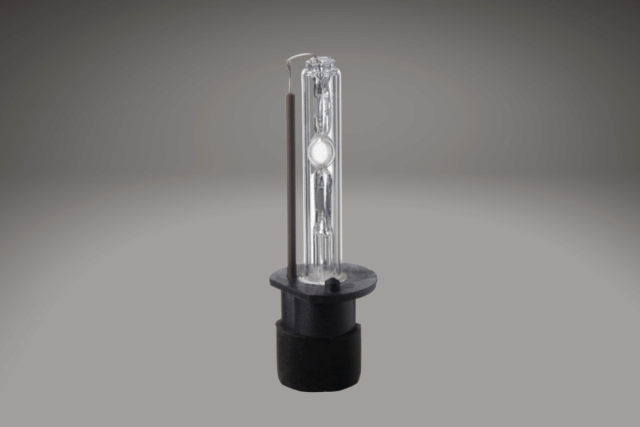
The electric arc from the electrodes heats the bubble mixture into plasma. As a result, the bubble will release a high-intensity light discharge.
The bubble takes a few seconds to heat up and discharge the bright light. But once it does, the brightness is far more than that of halogen headlights.
The presence of xenon gas in the bubble has made HID lightbulbs to be also dubbed as xenon lightbulbs.
Cost
An HID headlight typically costs between $20 to $50.
The cost depends upon a lot of factors including – brand, model, usage, power wattage, and color temperature.
The higher-end these factors like power, temperature, and brand, the higher will be the price.
These factors aside, HID lights cost more than halogen lights typically. If you are planning to buy a high-end halogen lightbulb that costs north of $25, it is worth looking into HID lightbulbs.
Bottomline, HID lights are costlier than halogen lights. Which, makes sense given all the advantages it has over halogen lights.
Luminous Intensity
Typically, an HID lightbulb in a motorcycle is 3x times brighter than a halogen lightbulb.
So, obviously, their luminous intensity will be higher than halogen lightbulbs.
An HID light bulb has a luminous intensity between 2500 to 3500 lumens. Compare that to a halogen lightbulb which produces between 800 to 2000 lumens.
Lifespan
HID lights have a higher lifespan than halogen lights. But it is still far lower when compared to LED lightbulbs.
HID lightbulbs have an average lifespan of 2000 hours. Almost twice the lifespan of halogen lightbulbs.
The higher lifespan is primarily because the HID lights do not have tungsten filaments like halogen lights that burn out.
Pros
- Bright light. 3x times brighter than halogen lights.
- Higher lifespan than halogen lights. Lasts 2000 hours.
Cons
- The lightbulb needs a ballast to manage its high voltage requirements.
- Installation, especially on halogen headlights, is too difficult.
- Does not light up instantly. Takes a few seconds to heat up and discharge light.
#3: LED Headlights
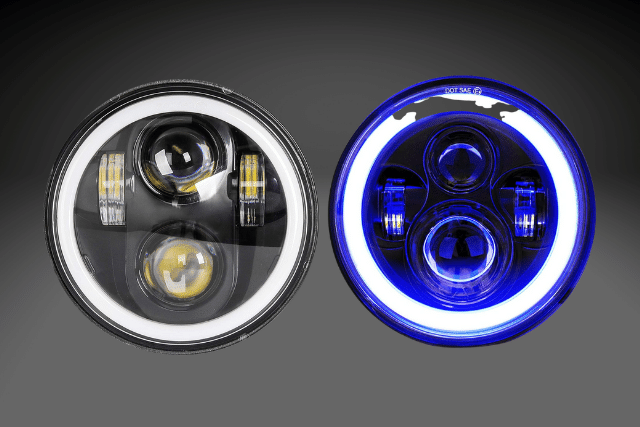
LED (light emitting diode) light as the name suggests powers up a diode to emit light rays.
LED lights do not have all the ballast and voltage complications that HID lights have. All the add-ons, the ballast, and the cooling fan – are all merged into the bulb itself.
As a result, LED lights are bulky. If you want to switch to LED lights in your motorcycle make sure the headlight area has enough space for it.
Installing a LED light on your motorcycle is easy and simple. All you need to do is choose the right fitment and plug the lightbulb in.
The light emitted by the LED is as bright as HID lights. In fact, it is a step better since the light is emitted without a lag of a few seconds, unlike HID ones.
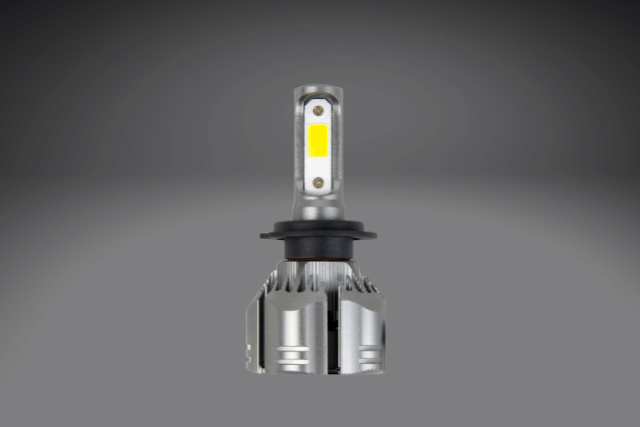
LED lights are white in color. You won’t notice any bluish tinge as you see in HID lights here.
If you are planning to buy a LED light, go for one which has multiple faces. The LED light shines bright. So multiple faces on the bulb provide bright light in all directions.
So, don’t buy a single-face LED. Unless you prefer retina-piercing extremely one-sided bright light.
Composition
LED lights are semiconductor device that emits light when electricity is passed through them.
LED lights, as the name suggests, have a semiconductor setup of light-emitting diodes. These diodes emit light when powered up with electricity.
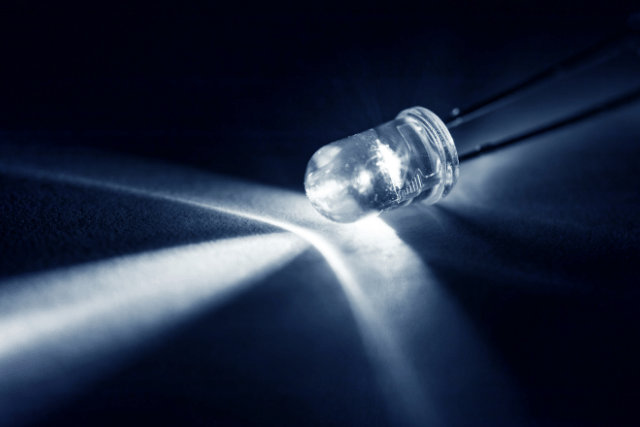
The LED works on the principle of electroluminescence. In simple words, low-energy electrons are used to bombard a sample, usually a semiconductor, which then releases photons. Photons are nothing but light rays.
In even simpler words, when electricity is passed through the semiconductor material (a diode in this case), it emits photons (the light).
There is no relying on heat energy here to produce light. As a result, LED lights are far more energy efficient.
Cost
LED lights cost around $40 to $90.
The high cost compared to halogen and HID lights are justifiable. LED lights, after all, are brighter and last longer. Far longer in fact.
For motorcycle headlights, you can get the entire LED headlight for around $120 to $150. There is no need for messy LED light installation in a halogen headlight design on the motorcycle.
Luminous Intensity
LED lights are bright. Brighter than the other two. So, these lights having high luminous intensity should come as no surprise.
The luminous intensity of LED lights ranges from 5000 to 8000 lumens.
Some high-watt LED bulbs even have as high intensity as 10,000 lumens.
Lifespan
LED lights have an insanely higher lifespan compared to halogen and HID lights.
Halogen lights have an average lifespan of 1000 hours. HID lights last around 2000 hours. But LED lights have a lifespan of 15,000 to 30,000 hours.
That is a 10x to 20x times difference in lifespan. There is no denying that LED lights are the best lightbulbs when it comes to high lifespan.
In fact, many LED light bulb manufacturers provide a lifetime warranty. Betting on the likely possibility that the LED bulb will crash, be stolen, sold, or get damaged before it quits.
Pros
- Bright light. Brighter than HID lights. Far brighter than halogen lights.
- Long-lasting light bulbs. A lifespan of 15,000 to 30,000 hours.
- Do not have ballast and voltage complications like HID lights.
- Energy efficient.
Cons
- Bulky in volume. Installation can be difficult in headlights designed for halogen lights.
- Too much brightness. Can be irritating when lights up on other people’s eyes.
Halogen vs HID vs LED – Comparison

To sum up the above sections, here is the table comparing these three lights – halogen, HID, and LED across different parameters:
| Parameter | Halogen light | HID light | LED light |
|---|---|---|---|
| Typical light color | Yellow | Bluish-white | White |
| Brightness | Low | High | High |
| Replacement & Installation | Easy | Difficult | Easy |
| Luminous Intensity | 800 to 2000 lumens | 2500 to 3500 lumens | 5000 to 8000 lumens |
| Lifespan | 1000 hours | 2000 hours | 20,000 hours |
| Cost | $10 to $30 | $20 to $50 | $40 to $90 |
| Energy Efficiency | Low | Medium | High |
Which is better?
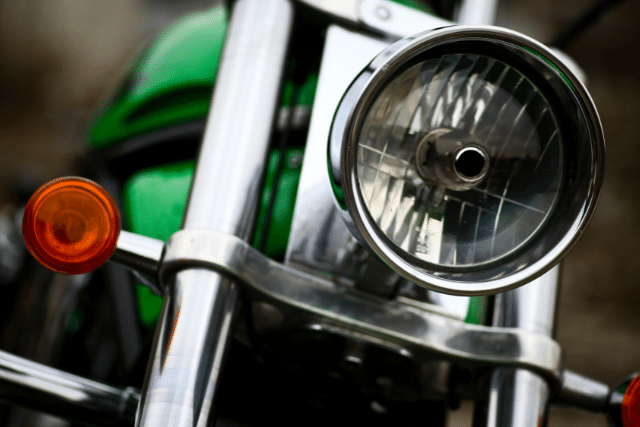
After all these comparisons, there comes the million-dollar question. Which headlight is better? Halogen or HID or LED?
In terms of performance and longevity, LED lights are the best. There is no doubt about that.
LED lights are brighter, and last far longer than halogen or HID lights. Far more energy efficient. Easy to install. And even comes as an entire headlight kit.
The only downside is a slightly higher cost. But the advantages that come with the increased cost are worth it. More than worth it if you ask me.
But, LED lights are too bright. Not everyone loves it. Few motorcycle riders prefer low-intensity lights that do not blind people’s eyes. (Not literally blind, but annoyingly blind).
So, if you do not like such high brightness, halogen or HID lights are the best.
HID lights are bright too. Plus, their installation is difficult. So, if not LED, then I would go for halogen lights as the next best option.
How to choose the headlight for the motorcycle?
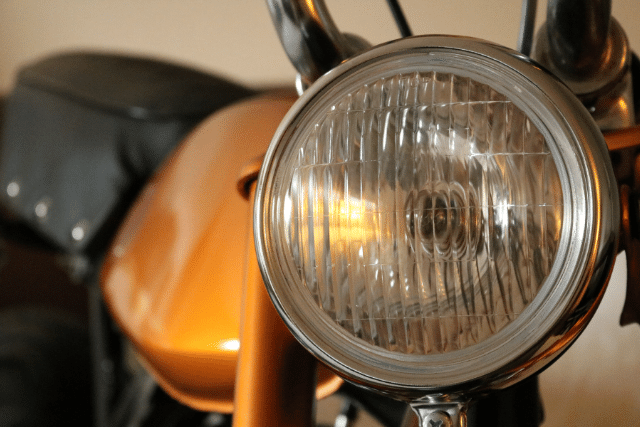
Just because LED lights are the best does not mean you should necessarily go for LED lights in your motorcycle headlights.
To choose the right headlight for your motorcycle, here are some of the factors you should consider.
How bright do you want your headlight to be?
Brighter does not necessarily mean better.
Motorcycle headlights when they are too bright can be blinding. The lights can be too up in people’s eyes who are driving opposite to you.
This is especially true for HID and LED lights fitted in motorcycles with halogen lightbulb setups. The reflectors which are adjusted for halogen lightbulbs, do not work too well for HID or LED lights.
On the other hand, HID and LED lights are indeed better in terms of luminous intensity and brightness.
For riders who prefer night riding, HID or LED headlights feel far superior to halogen ones.
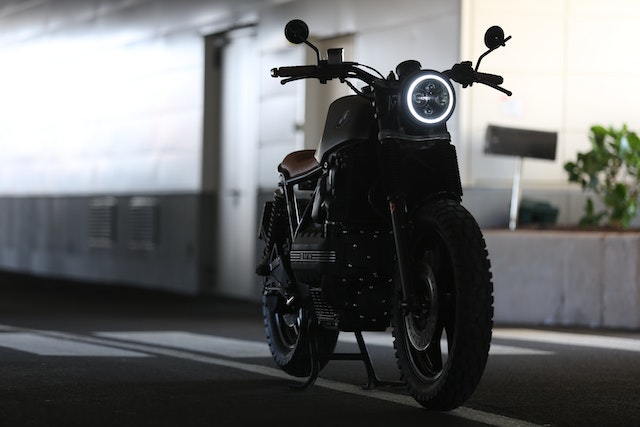
So, how bright do you want your motorcycle headlight to be?
If you do not want too much brightness, go for halogen lights. If you prefer high brightness, go for HID or LED lights.
Within each type, you can go for high or low brightness by going for different wattage bulbs. Typically, higher-watt bulbs are brighter.
What color temperature do you want?
Headlight color is something that motorcycle riders have a preference for. Surprising I know.
The lightbulb color depends on the bulb temperature measured in Kelvin. The higher the Kelvin temperature, the more white it will be.
Halogen lights are yellow and have the lowest color temperature. LED with its white color has the highest. HID falls in between with its bluish-white light color.
If you prefer yellow lights, go for halogen bulbs. If bluish-white is your preference, HID lights are the right one. And white light is what rocks your boat, go for LED lights.
How long do you want your headlight to last?
As long as possible. Of course, that’s the answer. But it comes with a tradeoff.
If you prefer halogen lights, you can’t expect longevity. Even HID lights, although better than halogen, still need replacement every 2 to 3 years.
So, decide how important the light’s longevity is to you. If longevity is at the top, go and buy LED lights. No more thinking required.
If longevity is not that big a factor, you can go for halogen or HID lights depending on your other preferences.
What watt bulb to go for?
Once you have finalized which type of lightbulb (halogen or HID or LED) you want in your motorcycle, time to pick the right wattage bulb.
Keep it simple. Use the same bulb power rating the OEM light had. If the OEM recommends a 35W lightbulb, go for a 35W lightbulb. That’s what your motorcycle headlight is designed for.
Also, as you increase the watts, the increase in luminous intensity will be lower and lower.
Sure, you can install a 55W bulb in place of 35W. But stretching it too far and going for a 100W bulb in place is risky. Avoid it.
If brightness is the issue, rather than going from 35W halogen to 100W halogen, switch to an HID or LED. In short, don’t play around with bulb wattage.
Last thing, check the opacity
Now that you are finalizing the bulb purchase, one last thing.
Most lightbulbs nowadays have a blue tint. The bulb glass is blue in color. This is especially true for HID lights. Even LED lights as well to an extent.
These headlights are tinged blue to filter out yellow color and make the light appear more white. It’s good. Nothing wrong with it.
But a high-quality bulb will be naturally whiter. And needs a less blue filter.
Also, too much blue tint reduces the bulb’s brightness. Higher the opacity, the lower the brightness.
So, given a choice, go for the lightbulb with a lower blue tint.
Conclusion
Personally, I like LED lights the most.
Once you install them as your motorcycle headlight, you do not have to worry for a long time. No hassles of replacing it every 2 to 3 years.
If you do not like LED lights and their retina-piercing brightness, I would suggest halogen lights. Halogen lights are cheap and easy to install. They do their job.
I am not a fan of HID lights. They are difficult to install. The ballast and voltage complications are too much for me. Plus, their lights are too bright as well.
So, either go for LED lights for their performance, brightness, and longevity. Or if you don’t want the lights to be too bright, go for halogen lights.